We then discussed the vineyards and walked around the property (which was
buzzing with work). Laurent is most proud of the vineyards that go into his
vintage wines. The youngest of these “vintage worthy” vines are 30 years old and
the Coeur de Cuvee is made from 50+ year old vines. Not many producers
can boast this many old vines. I asked Laurent what his plans were for
replanting and how long he planned on letting the vines continue to age and
produce. He said that he will take it year by year and as long as the vines are
giving good fruit, he sees no reason to pull them up. As we continued to walk
and talk, I couldn’t help but notice that people were constantly stopping by or
phoning in to place an order. I also liked that Vilmart offered a large tasting
area along with conference and banquet rooms. What better place to have a
meeting than at Vilmart? While I’m not sure you would get anything done, I can
guarantee that you will have fun drinking their Champagne!
 As for the wines, all are stored in oak for a minimum of 10 months. The NV
cuvees see aging in large oak foudres (3000-4000+ Liters) while the vintage
wines get small barrel treatment (around 225 Liters). For the vintage cuvees
that see oak, the Grand Cellier d’Or uses mostly “older” barrels while
the top of the line Cuvee Creation and Coeur de Cuvee see brand
new to 3 year old oak barrels. I put the word “older” in quotes because it is a
relative term. For Vilmart, old seems to mean anything that is more than 3 years
old. Compared to others like Krug, these “older” barrels at Vilmart are fairly
new.
As for the wines, all are stored in oak for a minimum of 10 months. The NV
cuvees see aging in large oak foudres (3000-4000+ Liters) while the vintage
wines get small barrel treatment (around 225 Liters). For the vintage cuvees
that see oak, the Grand Cellier d’Or uses mostly “older” barrels while
the top of the line Cuvee Creation and Coeur de Cuvee see brand
new to 3 year old oak barrels. I put the word “older” in quotes because it is a
relative term. For Vilmart, old seems to mean anything that is more than 3 years
old. Compared to others like Krug, these “older” barrels at Vilmart are fairly
new.
Over the last decade, oak has been about the only controversial subject with
Vilmart’s wines. Everyone agrees that the potential of the fruit is excellent,
but a few years back many thought that some of Vilmart’s cuvees went a bit
overboard on oak and had an awkwardness about them. However, outside of a few
early 1990s cuvees, I have always found the wines to be tasty and well balanced.
The fruit is rich and ripe and the amount of time the cuvees spend in the barrel
seems to be a good fit. Vilmart is also a believer in a solid Brut dosage
(meaning in the 7-11 g/L range) which helps the wines to age and achieve greater
balance between acid, fruit, and oak. Where many other growers short their wines
by going low with the dosage, Vilmart takes them to another level. Like a great
chef, Laurent is doing an excellent job with his spice collection (oak, dosage,
etc…).
Why these wines are still somewhat unknown outside of the wine geek circle is
beyond me. You want a cult wine, you got one right here. The house style is rich
and biscuity wines spiked with Christmas and baking spices. It is full throttle
Champagne with ripe fruit. If you want it tart and bland, look elsewhere!

* Note I have included the prices that I paid at the Vilmart cellar door in
Champagne for the bottles as well as the normal price these bottles sell for
here in the US (the NV Grande Reserve is not imported).
NV Grande Reserve
(30% Chardonnay, 70% Pinot Noir; Rilly la
Montange; Blend of 2003 and 2004 vintages; Aged a minimum of 10 months in large
oak casks; Disgorged May 2006; 13 Euros)
On the nose, this is slightly rough with some bitter citrus and spiced cream
aromas. Yet, it is quite rich in the mouth with flavors of creamy pears.
Initially there is a good dose of citrus, but it fades away rather quick and finishes up slightly short and sharp. Despite this, it is a full bodied
wine for a very low price (even with the weak dollar). Unfortunately, it is the
sole Vilmart wine not imported into the US. Grade of B-
(80-82 pts). Find this wine
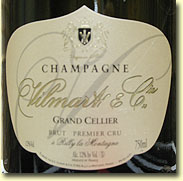 NV Grand Cellier
NV Grand Cellier
(70% Chardonnay, 30% Pinot Noir; Rilly la
Montange; Blend of 2002, 2003, and 2004 vintages; 30 year old vines; Aged a
minimum of 10 months in oak casks; Disgorged March 2006; 16 Euros; $45-$65 US)
This shows much more spice, bright pear, and citrus on both the nose and palate
than the Grand Reserve. A large dose of apples also joins in and leads the way
for a creamy and lively citrus and spice finish. Crank the richness and elegance
on the Grand Reserve up a notch and you have this baby. I haven’t always found
this wine that thrilling, but this particular cuvee of vintages is a wonderful
wine. Grade of B+ (87-89 pts). Find this wine
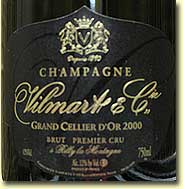 2000 Grand Cellier d’Or
2000 Grand Cellier d’Or
(80% Chardonnay, 20% Pinot Noir; Rilly la
Montange; 30+ year old vines; Aged a minimum of 10 months in oak barrels;
Disgorged March 2006; 19 Euros; $65-85 US)
Lots of spicy floral citrus and gentle cream aromas kick this wine off and lead
into a medium bodied mouth feel full of creamy citrus, vanilla, baking spices,
and juicy peaches. A goodbye wave is packaged up in a long finish with oak
tinged tart citrus. Compared to the NV Grand Cellier, this is bit leaner and
more tightly wound. They are very similar in terms of quality, but I would give
the slight edge to the more lively NV Grand Cellier for drinking today.
Grade of B+ (87-89 pts). Find this wine
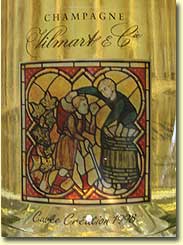 1998 Cuvee Creation
1998 Cuvee Creation
(70% Chardonnay, 30% Pinot Noir; Single vineyard in Rilly la Montange; 40-50
year old vines; Aged a minimum of 10 months in new oak barrels; Disgorged June
2006; 28 Euros; $85-100 US)
Laurent walked in with this bottle and told me I would love it. He was
very proud of how well it was drinking now and thought that along with the 1990,
it was his best Cuvee Creation to date. One whiff and I knew what he was talking
about. This is a huge wine and is better than the 1997 which I absolutely loved
(it is my favorite 1997 to date). Full of big biscuits, hot buttered rum,
spices, peaches, pears, and concentrated citrus, it is an explosive glass of hot
baked fruit cocktail pie. If you don’t like big and bold spicy fruit then avoid
this wine, but I love this hedonistic pleasure that knocks you down and has you
asking, “Please sir, may I have another!” And, if it means anything, I walked
out of Vilmart with more of this wine than any other cuvee.
Grade of Solid A (94-96 pts). Find this wine
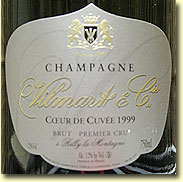 1999 Coeur de Cuvee
1999 Coeur de Cuvee
(80% Chardonnay, 20% Pinot Noir; Rilly la
Montange; Aged a minimum of 10 months in new oak barrels; 50 year old vines from
two vineyards; Disgorged May 2006; 31 Euros, $90-115 US)
Shows much more bright fruit than the Cuvee Creation and is much softer. 1999
was a softer vintage, but the different vineyards that go into this cuvee vs.
the Cuvee Creation also show their character here. Like any girl worth pursuing,
they make you wait to see them in full glory. While this will get better with
time, right now it gives me a lot of biscuity coconut and lemon meringue aromas
and flavors. In a nutshell, this is a tropical wine that shows hints of pina
colada and has a nice level of acidity so I would let it sleep. Like all the
other Coeurs, it will get better with time. Grade of A-
(90-92 pts) with the potential to improve to a High A- (91-93 pts). Find this wine
Laurent and I talked about the differences between the Cuvee Creation and the
Coeur de Cuvee and we both think the Cuvee Creation drinks best when young while
the Coeur de Cuvee is a wine that needs time to show what it really has. While
Cuvee Creation is my favorite, Laurent’s heart and soul go into the Coeur de
Cuvee and it is his pride and joy.
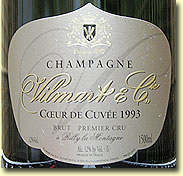 1993 Coeur de Cuvee (from Magnum)
1993 Coeur de Cuvee (from Magnum)
(70% Chardonnay, 30% Pinot Noir; Rilly la
Montange; Aged a minimum of 10 months in new oak barrels; Made from the oldest
vines from the best vineyards; Disgorged December 2006; 70 Euros, $200-$225 US)
On the nose, this shows creamy coconut, tangerine, and a wonderful accent of
gingerbread. Sweet vanilla spice, honeyed biscuits, baked pear, and peach
flavors highlight the palate. The finish is a bit harsh, but I am amazed at how
young this wine shows. Maybe it is time to drink original disgorgements of the
750 mL bottles, but these Magnums will only get better.
Grade of A- (90-92 pts) with Low A (92-94 pts) potential. Find this wine
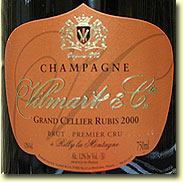 2000 Grand Cellier Rubis
2000 Grand Cellier Rubis
(40% Chardonnay, 60% Pinot Noir; Single vineyard
in Rilly la Montange; Aged a minimum of 10 months in new oak barrels; 50 year
old vines from two vineyards – This is basically a Coeur de Cuvee Rose; Red Wine
Addition; Disgorged November 2006; 31 Euros, $90-$115 US)
This proudly carries on the spicy, biscuity signature of the house while adding
in bright cherry blossoms and strawberry. A good dose of tannins takes grip on
the finish and lets you know that this is not only Champagne, but a serious
wine. Unfortunately, despite these positives, this lags a bit behind the other
vintage wines in my opinion. Maybe it is the vintage or my preferences, but I
found it a bit dry and bland once the initial fruit fades from the palate. For
my palate, I sometimes find it tough to enjoy Roses where all of the wine sees
oak. I feel it often dumbs down the bright fruit and I think that is what
happened here. While I can admire it for what it is, I just don’t think it
worked right for this vintage. It comes off like the goth child of the Vilmart
family. Give me more fruit and brightness and I would like it much more.
Grade of Solid B (85-86 pts). Find this wine
We also had some of Vilmart’s Ratafia made from 100% Pinot Noir. I quite
enjoyed its concentrated and sweet flavors. The alcohol is, of course, very
present and it was a bit much to take after all the bubbly, but I can see this
with a nice cheese platter or piece of thick, rich, creamy sweet cake.
Next stop - Jacquesson...
Cheers!
Brad Baker
Philipponnat |
Veuve Clicquot | Vilmart |
Jacquesson | Ruinart |
Goutorbe Part 1
Goutorbe Part 2 |
Henri Giraud | Chartogne-Taillet | Introduction
BACK TO THE TOP
BACK TO BRAD BAKER'S
INDEX PAGE
October 2007 © Brad Baker


 After visiting
After visiting 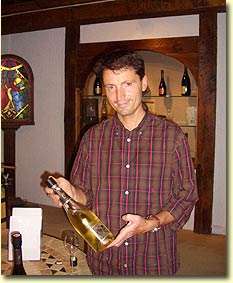 Now, it is no secret that I have long been a fan of Vilmart’s wines so when I
arrived, I jumped out of the car and raced inside to meet with winemaker/owner
Laurent Champs (left) and his assistant
Patricia. We started off by talking about the
current year’s weather. The 2007 growing season started out with an unusually
hot April and a somewhat mild June leaving hope that this will be a large,
healthy vintage and not a cooked one like 2003. While many producers have high
hopes for the 2007 vintage, Laurent didn’t seem as positive on it. He was
worried that the weather could still change for the worse (too much heat or too
much rain or both) and wasn’t too thrilled about the possibility of a mid-August
harvest. Much to everyone’s surprise things ended up a little more positive than
expected. While the vintage is certainly not a great one and it is still too
early to tell exactly what the end result will be, the hope for some good
vintage wines is still there.
Now, it is no secret that I have long been a fan of Vilmart’s wines so when I
arrived, I jumped out of the car and raced inside to meet with winemaker/owner
Laurent Champs (left) and his assistant
Patricia. We started off by talking about the
current year’s weather. The 2007 growing season started out with an unusually
hot April and a somewhat mild June leaving hope that this will be a large,
healthy vintage and not a cooked one like 2003. While many producers have high
hopes for the 2007 vintage, Laurent didn’t seem as positive on it. He was
worried that the weather could still change for the worse (too much heat or too
much rain or both) and wasn’t too thrilled about the possibility of a mid-August
harvest. Much to everyone’s surprise things ended up a little more positive than
expected. While the vintage is certainly not a great one and it is still too
early to tell exactly what the end result will be, the hope for some good
vintage wines is still there. As for the wines, all are stored in oak for a minimum of 10 months. The NV
cuvees see aging in large oak foudres (3000-4000+ Liters) while the vintage
wines get small barrel treatment (around 225 Liters). For the vintage cuvees
that see oak, the Grand Cellier d’Or uses mostly “older” barrels while
the top of the line Cuvee Creation and Coeur de Cuvee see brand
new to 3 year old oak barrels. I put the word “older” in quotes because it is a
relative term. For Vilmart, old seems to mean anything that is more than 3 years
old. Compared to others like Krug, these “older” barrels at Vilmart are fairly
new.
As for the wines, all are stored in oak for a minimum of 10 months. The NV
cuvees see aging in large oak foudres (3000-4000+ Liters) while the vintage
wines get small barrel treatment (around 225 Liters). For the vintage cuvees
that see oak, the Grand Cellier d’Or uses mostly “older” barrels while
the top of the line Cuvee Creation and Coeur de Cuvee see brand
new to 3 year old oak barrels. I put the word “older” in quotes because it is a
relative term. For Vilmart, old seems to mean anything that is more than 3 years
old. Compared to others like Krug, these “older” barrels at Vilmart are fairly
new.
 NV Grand Cellier
NV Grand Cellier 2000 Grand Cellier d’Or
2000 Grand Cellier d’Or 1998 Cuvee Creation
1998 Cuvee Creation 1999 Coeur de Cuvee
1999 Coeur de Cuvee 1993 Coeur de Cuvee (from Magnum)
1993 Coeur de Cuvee (from Magnum) 2000 Grand Cellier Rubis
2000 Grand Cellier Rubis